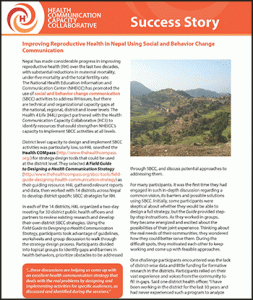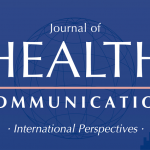Thinking Locally AND Globally: Health4Life in Nepal
 We’ve all heard the old adage: “Think globally, act locally.” Well, sometimes we need to think locally and globally. The Health4Life (H4L) project in Nepal recognized this need—when SBCC strategies are developed nationally, local needs and resources tend to be obscured. In partnership with the Health Communication Capacity Collaborative (HC3), H4L set out to build local capacity to develop district-level SBCC strategies.
We’ve all heard the old adage: “Think globally, act locally.” Well, sometimes we need to think locally and globally. The Health4Life (H4L) project in Nepal recognized this need—when SBCC strategies are developed nationally, local needs and resources tend to be obscured. In partnership with the Health Communication Capacity Collaborative (HC3), H4L set out to build local capacity to develop district-level SBCC strategies.
After searching the Health COMpass for resources that could help them build local capacity to develop SBCC strategies, H4L selected A Field Guide to Designing a Health Communication Strategy. With this resource as their guide, H4L gathered district public health officers and partners across 14 districts and engaged them in developing strategies tailored to each district’s needs and resources. Participants reported learning a great deal about strategy development and collaboration. One district public health officer said, “These discussions [in the strategy development workshop] are helping us come up with an excellent health communication strategy that deals with the real problems by designing and implementing activities for specific audiences.”
District partners were not the only ones learning from the capacity building process. H4L’s experience utilizing A Field Guide to Designing a Health Communication Strategy provided insights on how the document and process could be improved for use at the district level. Here are some of their recommendations and lessons learned:
- To develop an effective district-level strategy, you need data from the district level. Before a strategy development workshop, check thoroughly to find data that already exists. Consider conducting some formative research once you identify gaps. This will help you enter the workshop with much of the data you need to develop the strategy.
- It is a good idea to invite local health workers from the communities to participate in the strategy development. They have daily contact with clients and can provide insights others may not have.
- To ensure optimal participation, it is helpful to hold the strategy workshops far from participants’ offices. Otherwise, you run the risk of participants leaving for meetings and other work-related tasks.
- Provide participants with guidelines prior to the workshop so they have clear expectations about what ideas and information they should bring to the workshop.
- In Nepal and India, the guide worksheets would benefit from including additional columns for district and caste so participants can appropriately understand the situation and tailor the strategy.
- Often, workshop participants come from a variety of backgrounds. Spending some time at the beginning of the workshop to establish common terminology and explain concepts will help avoid confusion and lengthy discussions throughout the workshop.








Leave a Reply
Want to join the discussion?Feel free to contribute!